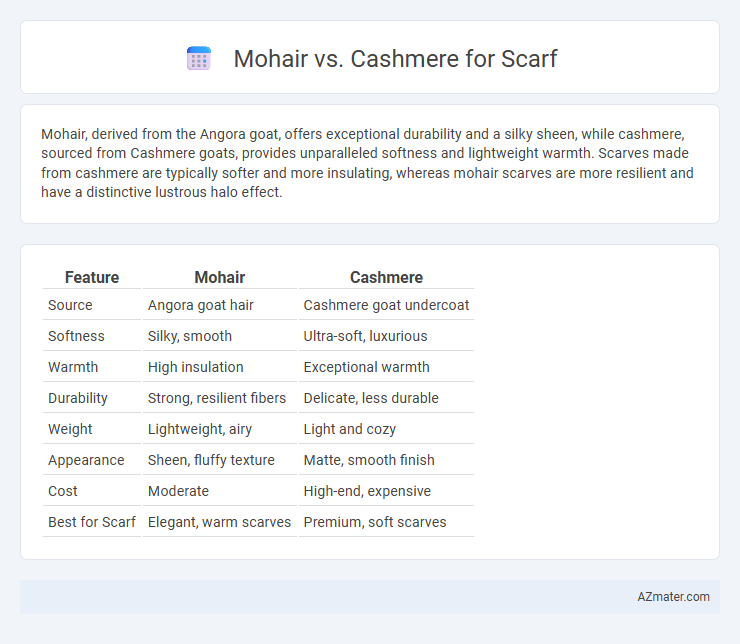Mohair, derived from the Angora goat, offers exceptional durability and a silky sheen, while cashmere, sourced from Cashmere goats, provides unparalleled softness and lightweight warmth. Scarves made from cashmere are typically softer and more insulating, whereas mohair scarves are more resilient and have a distinctive lustrous halo effect.
Table of Comparison
| Feature | Mohair | Cashmere |
|---|---|---|
| Source | Angora goat hair | Cashmere goat undercoat |
| Softness | Silky, smooth | Ultra-soft, luxurious |
| Warmth | High insulation | Exceptional warmth |
| Durability | Strong, resilient fibers | Delicate, less durable |
| Weight | Lightweight, airy | Light and cozy |
| Appearance | Sheen, fluffy texture | Matte, smooth finish |
| Cost | Moderate | High-end, expensive |
| Best for Scarf | Elegant, warm scarves | Premium, soft scarves |
Introduction: Mohair vs Cashmere for Scarves
Mohair, derived from the Angora goat, offers a lustrous sheen and exceptional warmth, making it a popular choice for scarves that combine softness with durability. Cashmere, sourced from the undercoat of Cashmere goats, is renowned for its unparalleled softness and lightweight insulation, providing luxurious comfort against the cold. Both fibers excel in thermal regulation and style, but Mohair tends to be more resilient while Cashmere delivers a finer, more delicate texture for high-end scarves.
Origin and Source of Mohair and Cashmere
Mohair is derived from the Angora goat native to Turkey, renowned for its silky and lustrous fibers that provide warmth and durability, while Cashmere comes from the undercoat of Cashmere goats primarily found in the mountainous regions of Mongolia, China, and Iran, known for its exceptional softness and insulating properties. The production of Mohair involves shearing the Angora goat twice a year, yielding long, strong fibers, whereas Cashmere requires combing the fine undercoat during molting season, producing finer and more delicate fibers. Both fibers maintain distinct regional origins that influence their texture, strength, and exclusivity in scarf manufacturing.
Texture and Softness Comparison
Mohair fibers, harvested from the Angora goat, offer a silky, smooth texture with a natural sheen and moderate softness, making them lightweight and warm for scarves. Cashmere, derived from the undercoat of Kashmir goats, is renowned for its exceptional softness, fine fibers, and luxurious texture, providing a plush and gentle feel against the skin. While mohair scarves are durable and have a slight halo effect, cashmere scarves excel in softness and warmth, often preferred for their superior comfort and insulation.
Warmth and Insulation Properties
Mohair fibers provide excellent warmth due to their hollow core, which traps heat efficiently, making them highly insulating for scarves. Cashmere offers superior softness with fine, dense fibers that create a lightweight yet effective thermal barrier. Both materials excel in insulation, but mohair tends to retain more heat in extreme cold conditions while cashmere balances warmth with breathability.
Durability and Longevity
Mohair scarves, derived from the Angora goat, are known for their exceptional durability and resistance to wear, making them ideal for long-term use. Cashmere scarves, sourced from Cashmere goats, offer a softer texture but tend to be more delicate and require careful maintenance to preserve their quality. Choosing mohair ensures greater longevity, while cashmere provides luxury with a need for gentler handling.
Breathability and Comfort
Mohair scarves, derived from the Angora goat, offer excellent breathability due to their hollow fiber structure, which allows air circulation and moisture-wicking properties, making them ideal for moderate climates. Cashmere, sourced from the undercoat of Cashmere goats, provides superior softness and insulation, delivering unparalleled comfort but with slightly less breathability compared to mohair. Both fibers create luxurious scarves, yet choosing mohair enhances airflow and moisture control, while cashmere prioritizes warmth and a plush feel.
Allergenicity and Skin Sensitivity
Mohair scarves are generally less allergenic due to their smooth fibers derived from Angora goats, making them suitable for sensitive skin. Cashmere, sourced from Himalayan goats, tends to be softer but can cause irritation in individuals allergic to lanolin or with extremely sensitive skin. Both fibers offer warmth and luxury, but cashmere's higher lanolin content increases the risk of allergic reactions compared to the hypoallergenic properties of mohair.
Style and Visual Appeal
Mohair scarves boast a lustrous sheen and fluffy texture that create a bold, luxurious statement, often featuring vibrant color options that enhance visual appeal. Cashmere scarves offer a refined, smooth finish with a subtle drape, exuding classic elegance and versatility suitable for both casual and formal styles. The choice between mohair and cashmere scarves hinges on preference for striking texture versus understated sophistication in fashion ensembles.
Price and Value for Money
Mohair scarves generally offer a more affordable price point than cashmere, making them a budget-friendly choice without sacrificing warmth and softness. Cashmere delivers superior luxury and exceptional softness, usually at a higher cost that reflects its rarity and fine quality. The value for money depends on whether the buyer prioritizes affordability or indulgent comfort, with mohair excelling in cost-effectiveness and cashmere in premium quality.
Sustainability and Ethical Considerations
Mohair scarves are derived from Angora goats, offering a renewable and biodegradable fiber with slower environmental degradation compared to synthetic alternatives. Cashmere comes from the undercoat of Cashmere goats, yet its production often faces scrutiny due to overgrazing and land degradation in key sourcing regions like Inner Mongolia, raising sustainability concerns. Ethical considerations prioritize transparent supply chains, animal welfare standards, and certifications such as the Responsible Wool Standard to ensure responsible sourcing for both mohair and cashmere scarves.

Infographic: Mohair vs Cashmere for Scarf
 azmater.com
azmater.com